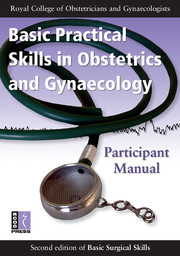Outline of the course
Published online by Cambridge University Press: 05 July 2014
Summary
Day one
□ Introduction to the course
□ Principles of safe and effective surgery (lecture)
□ Gloving and gowning (demonstration/practical)
□ Handling instruments (video demonstration/practical)
□ Knot tying (video demonstration/practical)
□ Suturing (video demonstration/practical)
□ Anatomy of anterior abdominal wall and surgical incisions into the abdomen (lecture/video)
□ Opening and closing the abdomen (practical)
□ Principles of haemostasis (practical)
□ Specific instruments for use in obstetrics and gynaecology (demonstration)
Day two
□ Anatomy of the female pelvis and vaginal birth (lecture)
□ Scenario 1: ventouse delivery, manual removal of placenta, episiotomy and perineal repair
□ Scenario 2: pudendal block and forceps delivery, shoulder dystocia, postpartum haemorrhage (video demonstration/practical)
□ Scenario 3: cardiotocograph interpretation, fetal blood sampling, caesarean section and documentation (video demonstration/practical)
Day three
□ Endoscopic equipment: ‘Meet the stack’ (demonstration)
□ Electrosurgery (lecture/video)
□ Principles of safe and effective hysteroscopy (lecture/video)
□ Laparoscopy and entry (lecture/video)
□ Demonstrations and practicals:
Station 1: gynaecological examinations/pelvic swabs/smear taking/endometrial biopsy/intrauterine contraceptive device insertion
Station 2: basic hysteroscopy/uterine evacuation
Station 3: principles of closed laparoscopic entry
□ Laparoscopic skill stations and laparoscopic entry scenario (practical)
□ Course review followed by free session for personal learning and revisit to stations (if required to complete course)
- Type
- Chapter
- Information
- Basic Practical Skills in Obstetrics and GynaecologyParticipant Manual, pp. 3 - 4Publisher: Cambridge University PressPrint publication year: 2010



